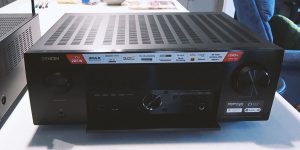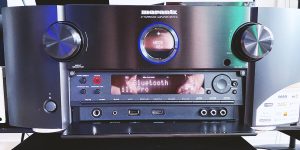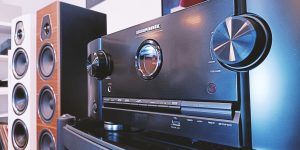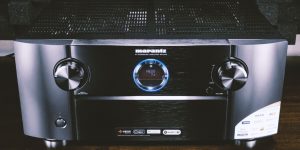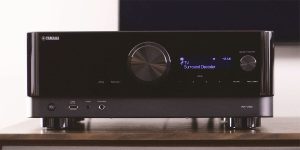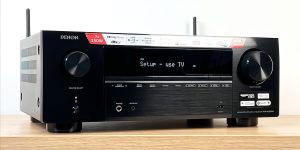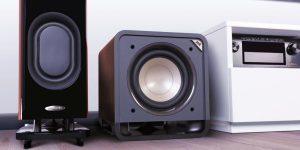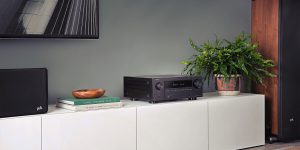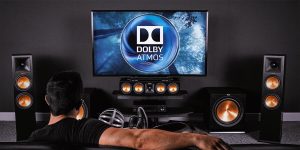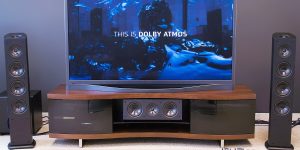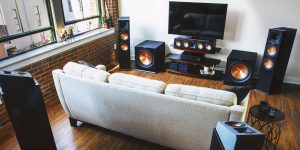Dolby Atmos technology has been gaining momentum lately, and more and more home theater owners are thinking about it. Receiver manufacturers are keeping up with the times and releasing more devices with Atmos support, including at a low price. In this article, I’ve picked the five best budget Dolby Atmos receivers that won’t empty your pockets. These models provide complete Atmos support (no “Virtual speakers”), and I’m sure you’ll find one right. After all, Dolby Atmos has no equal in sound realism, and more and more new movies and content are coming out in this format. Along the way, I’ll answer some common questions about the technology, which will also help you understand its benefits.
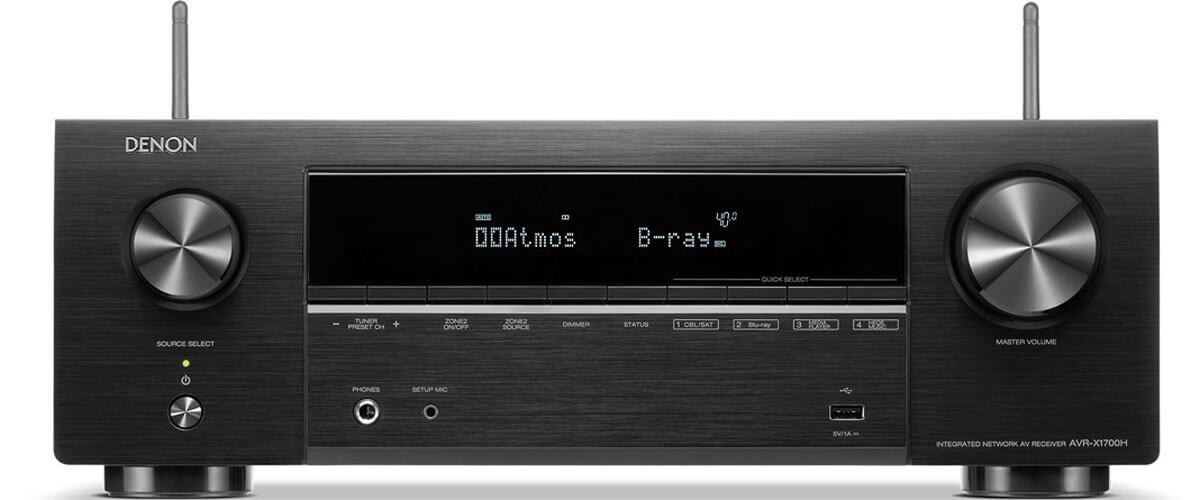
Budget Dolby Atmos receiver comparison table
| Name | Channels | Power output | HDMI in/out | Bluetooth/Wi-Fi | Review |
|---|---|---|---|---|---|
| Denon AVR-X1700Hbest overall | 7.2 | 80W/8 Ohm, 120W/6 Ohm | 6/1 | yes/yes | Review |
| Yamaha RX-A2A also great | 7.2 | 100W/8 Ohm | 7/1 | yes/yes | Review |
| Sony STR-DH790 the cheapest | 7.2 | 145W/6 Ohm | 6/2 | yes/no | Review |
| Onkyo TX-NR7100 budget | 9.2 | 100W/8 Ohm, 220W/6 Ohm | 7/2 | yes/yes | Review |
Best budget Dolby Atmos receiver reviews
Denon AVR-X1700H – best overall
Given the competitiveness of the modern AV receiver market, Denon had to take a bold step to strike its competitors. From the first glance at AVR-X1700H specifications, I realized that the competition would be fascinating. And I wasn't wrong back then.
The Marantz has a slim but mighty 5.2 channel NR1510 receiver in this price range. In turn, Yamaha doesn't seem to take a backseat with their 5.2 channel RX-V4A. And when the Denon cavalry, the AVR-X1700H, arrived in October 2021, the market already had the AVR-X2700H. Nevertheless, the hero of my review is not the most expensive model among analogs and is cheaper than the X2700H. So now, when some time has passed, I can make a comprehensive Denon AVR-X1700H review to see whether this unit is actually worth all the fuss around.
Design

The AVR-X1700H is not a trendsetter when it comes to design. I didn't manage to find much of a change when comparing the X1700H with X2700H. A classic black box with convenient control surfaces and a big readable screen in the middle. Dimensions are also relatively standard for this price range, 17.1× 13.3 × 6 in. The AVR-X1700H weighs slightly less than the AVR-X2700H - 18.96 lbs vs. 21.
After unpacking the receiver and holding it in the hands, it felt solid and rigid, giving a feeling of holding a costly and quality unit. No strange noises or scary crunch sounds that one may have from more simple units. Even though the AVR-X2700H is more expensive, it has the same case and quality. This aspect enormously benefits the AVR-X1700H, as in some cases, more affordable AV receivers have cheaper cases.
Features and specs
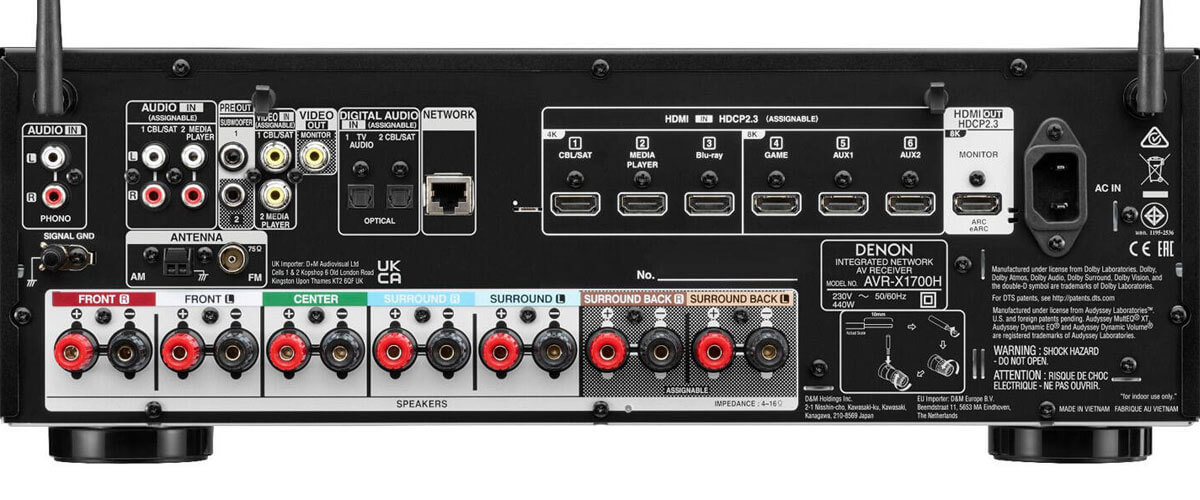
Denon AVR-X1700H has the situation firmly in hand by being a 7.2 Ch AV receiver. For comparison, Marantz, in the same price range, offers 5.2 NR1510, and Yamaha also comes with 5.2 channel RX-V4A. Denon also surpasses its competitors in terms of power, offering 80W with 8-ohm speakers, 20 Hz - 20 kHz, 0.08%. It is enough to fill the middle-sized room with immersive sound, especially with the help of supported Audyssey MultEQ XT and DTS:X technology trees.
Denon has an advantage, having 6 HDMI inputs (HDCP 2.3), 3 of which support 8K resolution at 60 Hz. At the same time, as all analogs, Denon AVR-X1700H features include only a single HDMI output. It also contains 2 composite inputs, a single output, 7 speaker terminals, 2 outputs for subwoofers, assignable bi-amping, an FM antenna, has built-in Wi-Fi and Bluetooth. The receiver fully supports Zone 2 feature, which also gives the AVR-X1700H advantage over the NR1510 from Marantz. The latter supports only HEOS-compatible speakers, with no multi-room feature.
In terms of video capabilities, all HDMI support 4K/120Hz, and, as I have mentioned before, only 3 are 8K/60Hz capable. The AVR-X1700H offers almost complete support of the DTS:X technology family, apart from DTS Neo:X. The same goes for the help of the latest Dolby technologies. But in this case, the only exception is Dolby ProLogic II. HDMI to HDMI scaling and HDR 10+. In terms of video features, the receiver stands alongside its competitors without significant flaws or advantages, with specific characteristics that partially equal it to more expensive models.
Listening experience
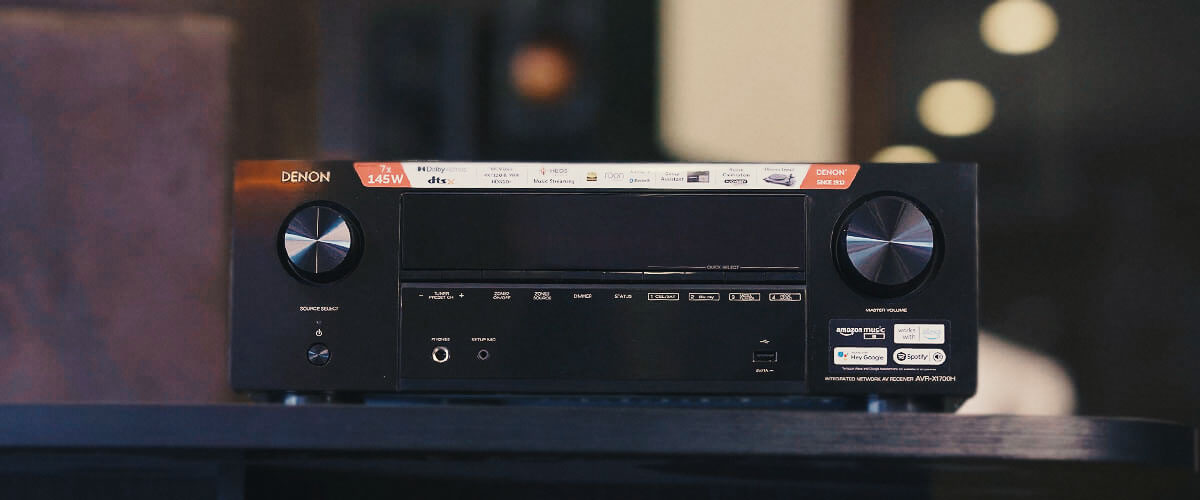
The AVR-X1700H has a pretty pleasant sound when listening to music, showing similar results with a different genre. The level of detail, stability, and vibrato can almost be compared to AVR-X2700H. Compare these two blindfolded, and you won't find much difference in music. With movies, The AVR-X1700H shows detailed, steered, balanced sound. Despite not having the highest power, it delivers just enough to fill a medium-sized room with immersive sound. Two subwoofers work great, delivering theater-like sound.
Denon habitually plays one of the leading companies in the AV receiver industry. Their AVR-X1700H adhered to the company's tradition and didn't disappoint me during the test. It is a severe competitor of Marantz and Yamaha and an excellent choice for optimizing your multimedia system.
Key specs
- Channels: 7.2.
- Power output: 80W/8 Ohm, 120W/6 Ohm.
- HDMI inputs/outputs: 6/1.
- Video functions: 8K/60Hz, 4K/120Hz, 4K/60Hz pass-through, video upconversion (up to 1080p and 8K) for analog and HDMI sources.
- Bluetooth/Wi-Fi: yes/yes.
- Streaming services: AirPlay2, Deezer, Tidal, Pandora, SiriusXM, Napster, SoundCloud, Amazon Music, Amazon Music HD, Mood mix.
- Supports: HDMI ARC, HDMI eARC, HDMI CEC, HDCP2.3, HDR10, HDR10+, Dolby Vision.
- Surround sound: DTS HD Master, DTS Neural:X, Dolby TrueHD, Dolby Surround, Dolby Digital Plus, Dolby Atmos Height Virtualization, Dolby Atmos, Multichannel stereo.
According to the set of objective indicators and test results, I can call Denon AVR-X1700H the best budget Dolby Atmos receiver. Besides solving the main task, this receiver supports a number of additional technologies, which is a nice bonus to its basic features. It will give you good detail when watching movies and has enough power for a medium-sized room. One of its main advantages is the theatrical sound.
Pros
- Supports 8K/60Hz video.
- Supports Zone 2.
- Wi-Fi & Bluetooth.
Cons
- Not powerful enough for large rooms.
Yamaha RX-A2A – also great
The receiver plays a crucial role in the formation of a complete home theater. Many well-known brands release these devices on the market, but Yamaha has been one of the real leaders in the industry for many years. With these considerations in mind, I have prepared a Yamaha RX-A2A review for you today. The model was released in 2020, belonging to Yamaha's premium Aventage lineup. It is now the most affordable version of this series, combining optimal performance for most of your needs and a reasonable price.
Design
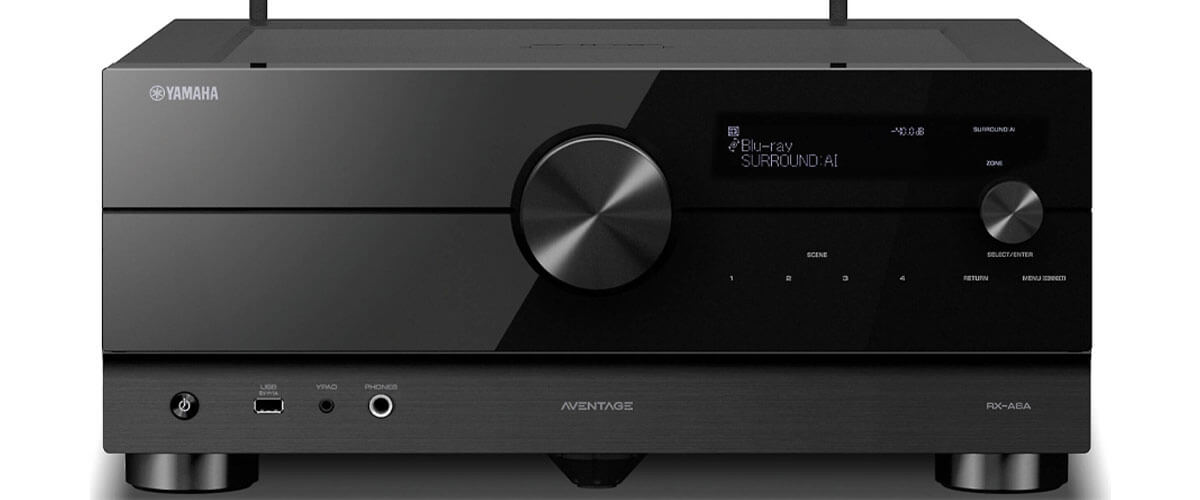
Yamaha has always distinguished itself from competitors through the elaborate design of its products. And the RX-A2A was no exception. The minimalistic design and the glossy black front panel of the device, on which there is a large volume knob in the middle, certainly draw attention.
To the right of the volume control, you will find 4 shortcut buttons. The power button, ports for the microphone, and headphones with 3.5 mm / 6.5 mm connectors are on the opposite side of the receiver, respectively. An excellent engineering solution is using a fifth leg in the center of the chassis model base, damping any vibrations, which positively affects the overall sound quality.
Features and specs
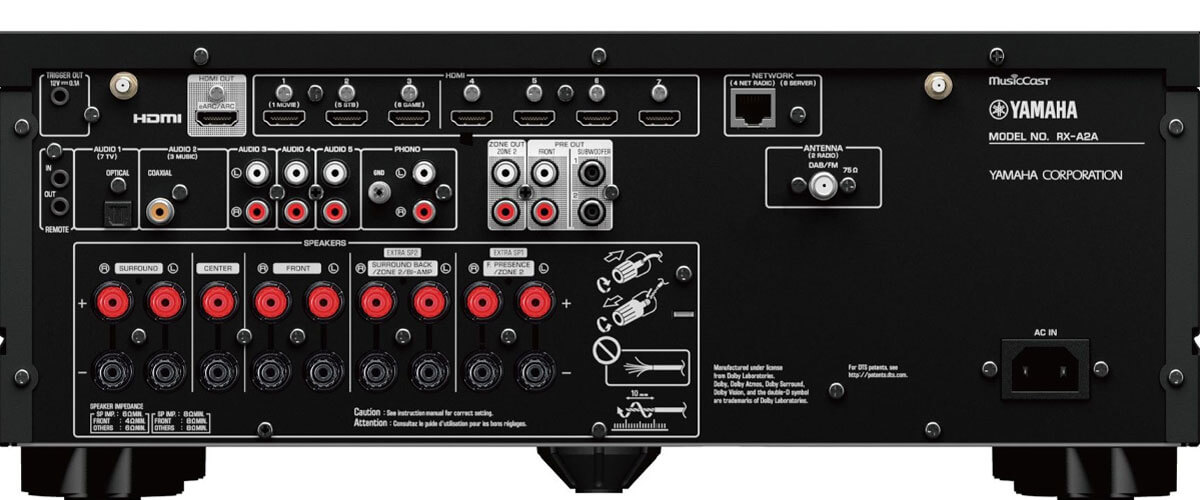
The Yamaha Aventage RX-A2A has a 7.2-channel amplifier with about 100 watts per channel (8 ohms, 20 Hz - 20 kHz, 0.06% THD). Since the device is the cheapest option from the premium class, it is equipped with a 384kHz/32-bit BB PCM5102A DAC. Of course, if you consider newer models, they are equipped with even better components. For example, the RX-A4A already has the latest Qualcomm QCS407 64-bit processor and Surround:AI.
But let's take a closer look at the RX-A2A specifications. It works with 4K resolution (120Hz), HDR10+, Dolby Vision, and Dolby Surround encodings. As a result, the picture looks quite bright and clear. This model also supports 8K resolution (60Hz) and advanced gaming capabilities. The only nuance to consider is that before you turn the receiver on, you must first activate the video synchronization of the TV. If this is not done, sometimes the sound and video will not be displayed, and the image format will be reduced.
There is also support for surround sound formats, such as DTS:X and Dolby Atmos. So watching movies will definitely take you to the next level.
As for connectors and connections, the receiver has 7 HDMI inputs (2.1) and 1 HDMI output (2.1) with HDCP 2.3 and eARC support. Available connection methods include 2 subwoofer outputs, Wi-Fi, USB inputs, network ports, Bluetooth, and Phono (MM) input.
Yamaha has two multi-room zones. This definitely expands the possibilities of using the receiver.This function allows you to enable playback from different sources in the main and Zone 2.
AirPlay 2 technology was also present in this model, allowing my iPhone to stream video and music to supported screens and speakers. So those who are worried about streaming services may not worry - they are also present here.
Listening experience
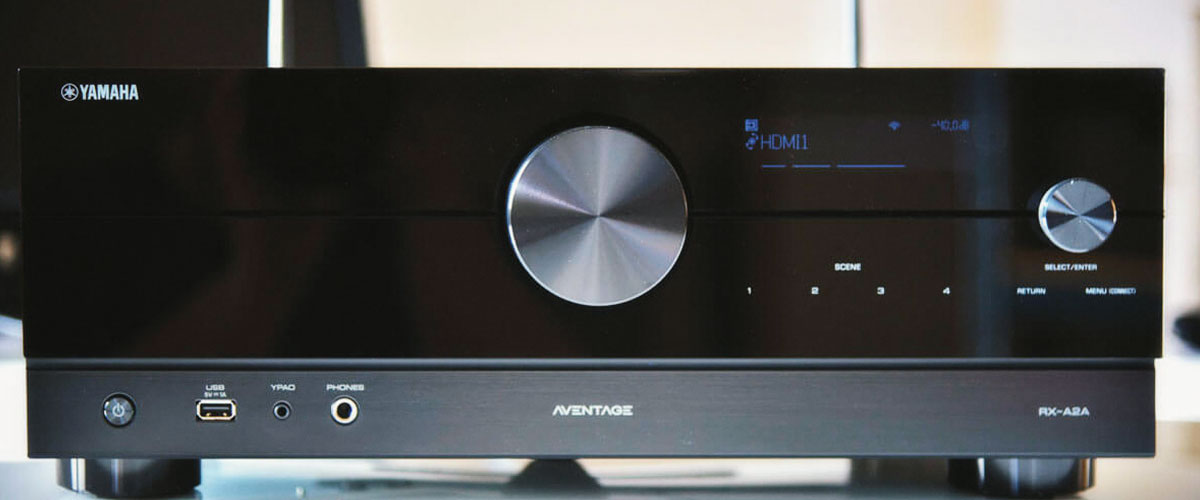
Before using the receiver, I first calibrated the sound with exclusive YPAO technology, and I must say, I achieved excellent results. Watching the movie "Fast and Furious 9" turned out to be quite a thrilling experience. The car chases sounded quite dynamic to me, and the squeals and truck drifts were pleasingly broad and fizzy. Thanks to the presence of surround sound technology, I was able to feel like I was in the middle of the action.
The explosions were less surprising. I'd say they sounded a little rough. As for the rest of the soundstage, it was neatly detailed.
During testing, I faced the problem of delayed sound several times. Namely, "Automatic Lip-sync" did not work correctly. It is hard to say whether this problem is present in all devices of this model or if it was just my "luck."
However, to summarize, I would like to note that the sound did not disappoint me, and although Yamaha RX-A2A is not the leader among the top models, you will definitely be satisfied with the unit for this money.
Key specs
- Channels: 7.2.
- Power output: 100W/8 Ohm.
- HDMI inputs/outputs: 7/1.
- Video functions: 8K/60Hz, 4K/120Hz, 4K/60Hz pass-through, video upconversion (up to 1080p and 4K) for analog and HDMI sources.
- Bluetooth/Wi-Fi: yes/yes.
- Streaming services: AirPlay2, Deezer, Tidal, Pandora, SiriusXM, Napster, SoundCloud, Amazon Music, Amazon Music HD, Mood mix.
- Supports: HDMI ARC, HDMI eARC, HDMI CEC, HDCP2.3, HDR10, HDR10+, Dolby Vision.
- Surround sound: DTS HD Master, DTS Neural:X, Dolby TrueHD, Dolby Surround, Dolby Digital Plus, Dolby Atmos Height Virtualization, Dolby Atmos.
It’s also a great inexpensive AV receiver. Yamaha RX-A2A is a 7-channel and multifunctional unit supporting most modern video and audio formats and streaming services. It produces realistic sounds with accurate detailing. Excellent price-quality ratio!
Pros
- CINEMA DSP 3D.
- YPAO.
- Compatible with wireless surround speakers.
- Multi-room audio system MusicCast.
- Phono input.
Cons
- Sometimes there is a sound lag problem.
Sony STR-DH790 – the cheapest
Are you wondering what a very inexpensive receiver has to offer today? Then my Sony STR-DH790 review will be helpful for you. This model is not much more expensive than STR-DH590, but it offers considerably more features in its parameters. Well, let's take a step-by-step look at the receiver's improvements, features, and capabilities, as I'm sure it could be trendy for its price if all expectations hold true. Let's go.
Design
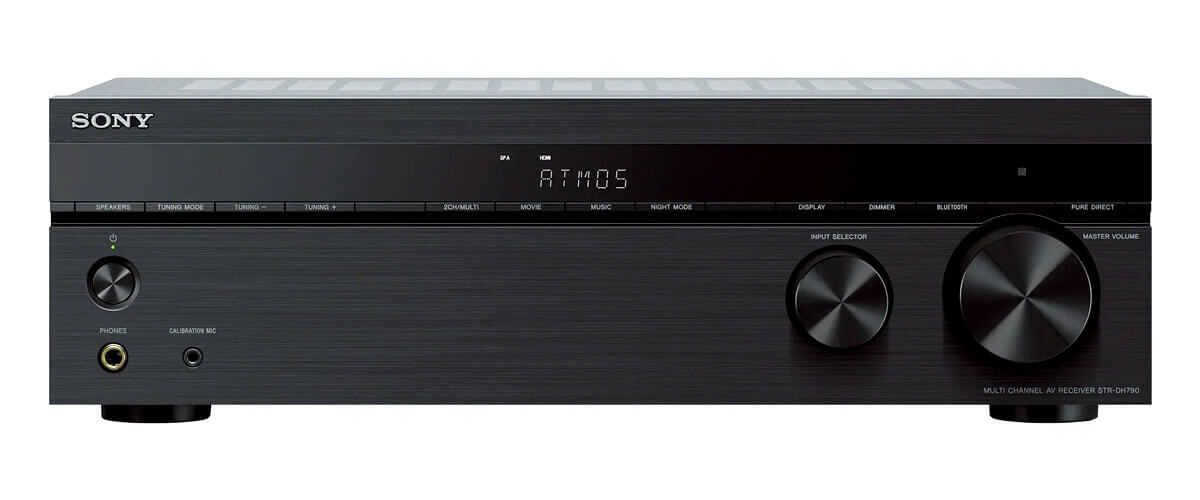
Externally, the two devices are indistinguishable. The black case in traditional Sony style measures 17" x 5-1/4" x 11-3/4" and weighs 16 lb 6 oz. The compact model has an LCD on the front panel with subtle control buttons underneath. You will find the power button on the left side, and on the right side, there are two round controls of different sizes: Input Selection and Master Volume. The only jacks here are Phones and Mic. Many users like to have an HDMI input on the front panel for quick access. I'm not too fond of wires, so minimalistic restrained exteriors are always a plus for me.
Features and specs
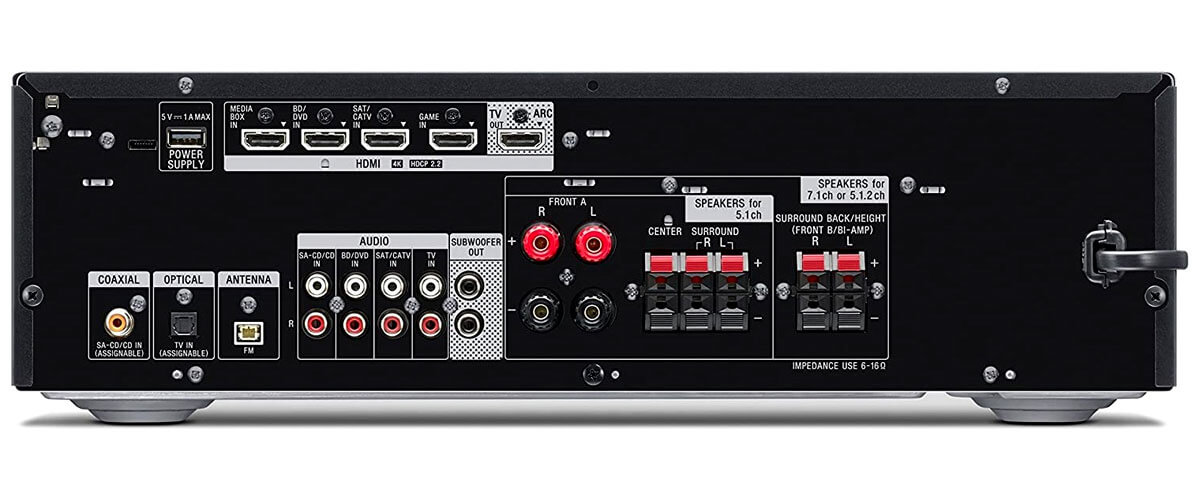
Well, we have a 7-channel receiver with the possibility to form a configuration like 5.1.2. The unit's power is 145 watts (6 ohms, 1 kHz, THD 0.9%, 1 ch).
For its price, STR-DH790 has pretty decent features. The channel organization allows bi-amping for the two front speakers, as well as speakers for Dolby Atmos and DTS:X. Rarely a model in this price range can boast support for these formats. For example, the STR-DH590 is designed only for older sound formats.
Four HDMI inputs in the receiver support 4K and UHD with up to 60 Hz, HDR10, HLG, Dolby Vision, 3D, Deep Colour, and HDCP 2.2. There is only one HDMI output. But unlike the DH590 model, here you will find an HDMI port with an enhanced audio return channel (eARC).
Of the other connection possibilities, there is a USB socket (5V/1A). But the lack of Wi-Fi or Ethernet was surprising. It is not a critical lack, but it certainly does not add to its versatility and usability. Although there is Bluetooth, which may well make up for this shortcoming, as it supports the AAC codec, which means listening to Apple will be without loss of quality.
Of course, we should have expected that the STR-DH790 specifications are limited. But we should remember how inexpensive it is. So, if you ask me, I think the receiver stands out from the crowd of competitors favorably. And in some respects, it is even pleasantly surprising.
Listening experience
Before testing the receiver, I checked the calibration microphone's tuning. Autocalibration determines the size of the speakers, levels, distances, and EQ. Not the most innovative system. I had to adjust some parameters manually. But it's easy. The movie I chose was saturated with all sorts of sound effects: The Hitman's Bodyguard. Great soundtrack, lots of detail, action, wheel rattling, and dialogue - just the thing. Well, the sound was surprisingly good. Needless to say, it could have been better. But in this particular case, it was great. There are few competitors for a Sony STR-DH790 in its price range. The Dolby Atmos sound surrounds and follows the picture, moving from one corner of the room to another, just as it should be for the feeling of being in a movie.
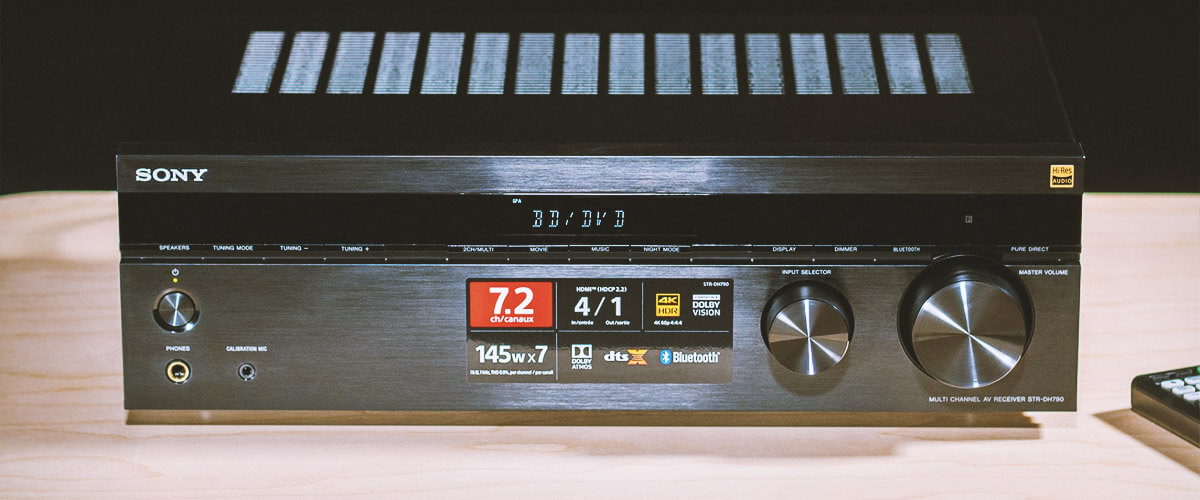
Key specs
- Channels: 7.2.
- Power output: 145W/6 Ohm.
- HDMI inputs/outputs: 6/2.
- Video functions: 4K/60Hz pass-through.
- Bluetooth/Wi-Fi: yes/no.
- Streaming services: no.
- Suppots HDMI ARC, HDMI eARC, HDCP2.2, HDR10, Dolby Vision.
- Surround sound: DSD, DTS-HD Master, DTS:X, Dolby Digital, Dolby Dual Mono, Dolby Atmos.
The cheapest Dolby Atmos receiver from Sony can be an excellent solution for those not ready to spend a lot of money on upgrading their system. Its support for the latest video and audio formats ensures its place in our chart, despite some shortcomings in functionality. Nevertheless, it can meet your basic needs to the fullest.
Pros
- Easy to set up.
- Accurately determines the distance between the position of the microphone and the speakers when calibrating the system.
- Works with Sony TV Android.
- S-Force PRO Front Surround and DCAC technologies.
- DSD format decoding.
- Pleasant warm sound.
- Compact design.
Cons
- No 8K support.
- No Wi-Fi.
- Can overheat during prolonged operation.
Pioneer Elite VSX-LX105
The modern AV receiver is a technological and multifunctional device capable of taking your emotions from watching movies and listening to music to another level. But it is often very difficult to decide which model can meet most of your needs. That's why I've prepared a Pioneer Elite VSX-LX105 review for you today. It is a model from one of the market leaders, which has been delighting fans with good products for many years.
The Japanese company Pioneer made the unit in 2021 as the most affordable premium model, designed exclusively for the American market. The more expensive VSX-LX series receivers are the Elite VSX-LX305 and Elite VSX-LX505.
Design

In terms of design, the VSX-LX105 doesn't differ much from its older brothers. Partly because Pioneer always tries to keep a certain style of its products. The receiver's front panel is not overloaded with various details, so it looks pretty minimalistic.
I liked having a large and well-readable screen in the model's center. There is one knob each on the left and right sides for input selection and volume control. USB and AUX inputs are very conveniently located. As for the power button and Phono input, you will find them in the left corner of the device.
Features and specs
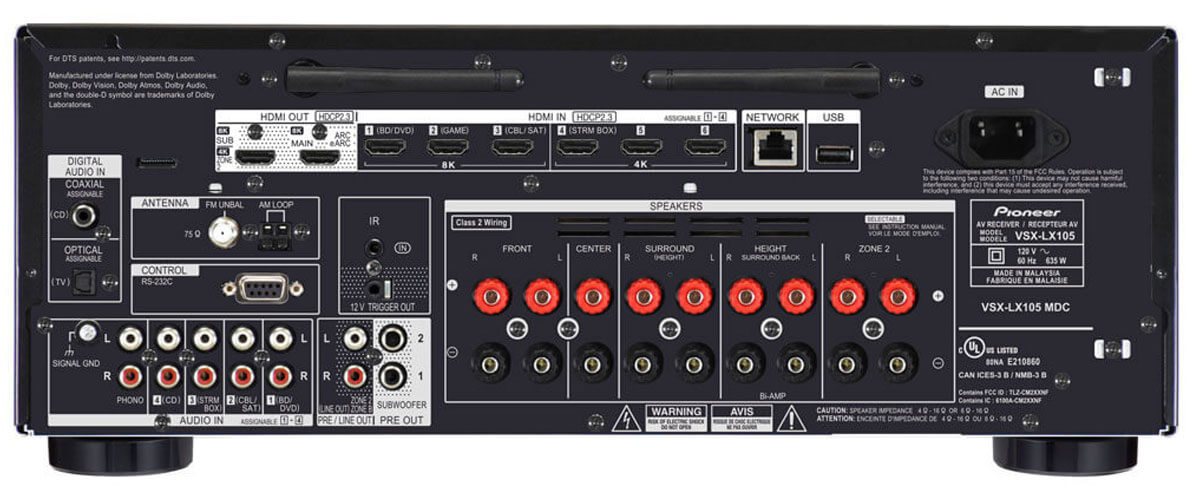
Well, now let's talk about the Pioneer Elite VSX-LX105 features. The receiver has a 7.2-channel amplifier with about 100 watts per channel (8 ohms, 20 Hz-20 kHz, THD 0.08%). In addition to the possibility of using 3 personal presets, it has also been profiled as Roon-Tested, thus guaranteeing perfect compatibility between different devices.
From the technical point of view, the receiver supports 8K resolution at 60Hz, Dolby Vision, and HDR10+ technologies. During image quality testing, I did not notice any malfunctions. The Forrest Gump movie (my favorite classic with lots of talks and action scenes) was played without interruptions or flickers. In general, the picture looked clear, vivid, and moderately contrasted.
Also, a good plus is the presence of two multi-room zones and enhanced gaming. But there is an important nuance here - the 8K pass-through is only available in Zone 1.
Speaking about connectors and methods to connect - everything is also good here. The device has 6 HDMI inputs (2.1) and 2 HDMI outputs (2.1), which are not always found in other models in a similar price range. In addition, the VSX-LX105 supports HDCP 2.3 and eARC technology. Furthermore, there are 2 subwoofer outputs, Ethernet ports, dual-band Wi-Fi, Bluetooth 4.2, and Phono (MM) In, among the available connection methods.
Now, as for the audio specifications of the Elite VSX-LX105. It supports surround sound formats such as Dolby Atmos and DTS:X. Thanks to Dolby Atmos Height Virtualization technology, it is also possible to create a virtual surround effect without additional overhead speakers. But most interestingly, the receiver is certified to work specifically with the Sonos ecosystem. So if you have a Sonos home audio system, you'll like the Sonos Port.
Listening experience
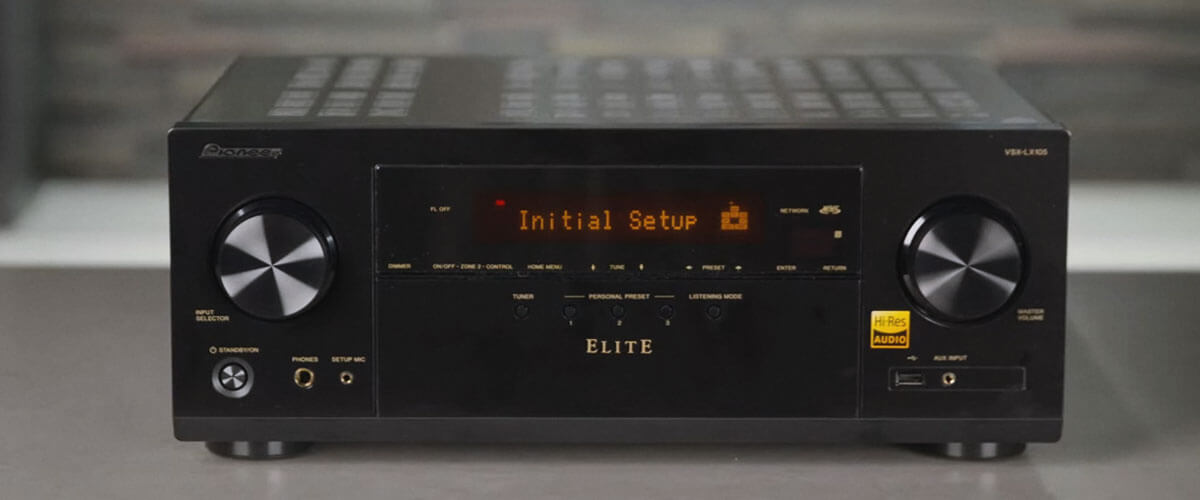
I calibrated the sound from the beginning with MCACC automatic room tuning technology. The sound was pretty easy to set up, so I don't think you'll have any problems with that. The test was conducted in two ways: I watched Forrest Gump and listened to music using AirPlay 2. In both cases, there was an immersive effect. All the details sounded realistic and, most importantly, clean. Although the distortion did not appear when I turned up the volume, I noticed that the receiver started overheating. That is why I ask you to pay attention to this.
Key specs
- Channels: 9.2.
- Power output: 100W/8 Ohm, 210W/6 Ohm.
- HDMI inputs/outputs: 6/2.
- Video functions: 8K/60Hz, 4K/120Hz, 4K/60Hz pass-through, video upconversion (up to 1080p and 8K) for analog and HDMI sources.
- Bluetooth/Wi-Fi: yes/yes.
- Streaming services: AirPlay2, Deezer, Tidal, Pandora, SiriusXM, Napster, SoundCloud, Amazon Music, Amazon Music HD, Mood mix.
- Supports: HDMI ARC, HDMI eARC, HDMI CEC, HDCP2.3, HDR10, HDR10+, Dolby Vision.
- Surround sound: DTS HD Master, DTS Neural:X, Dolby TrueHD, Dolby Surround, Dolby Digital Plus, Dolby Atmos Height Virtualization, Dolby Atmos.
The best budget Atmos receiver that has 7 channels and many different additional features. The sound is detailed, clear, realistic, and immersive. Incredibly, the manufacturer tried to equip the receiver with support of many formats at a relatively low price, making you happy for several years to come.
Pros
- Surround Enhancer technology eliminates the need for rear speakers.
- Supports 8K/60p and 4K/120p.
- MCACC acoustic room auto-calibration.
- Advanced Sound Retriever (2-channel) compressed sound quality restoration technology.
Cons
- Overheats at high volume.
Onkyo TX-NR7100 – budget
Onkyo is a manufacturing company originating in Japan. Despite its long history in making audio equipment and some of its popular home theater systems, most people still prefer to stick to Denon, Marantz, and Yamaha. I didn't hesitate to make the Onkyo TX-NR7100 review when I had the chance, even though this brand is somewhat out of earshot for most people. One can translate the company's name from Japanese as "harmony of sound." It resembles their main goal - making reliable sound equipment to feel our homes with sound and harmony.
Those interested in the industry probably already heard about their TX-SR393 receiver when the company tried to take the lower price segment of the market or their mid-range TX-NR696. In turn, the specification of this 9.2 channel is pretty optimistic, especially considering the price range and that the unit is full of modern technologies. So, I want to see how Onkyo tries to cut a slice for themselves of the AV receiver market pie.
Design
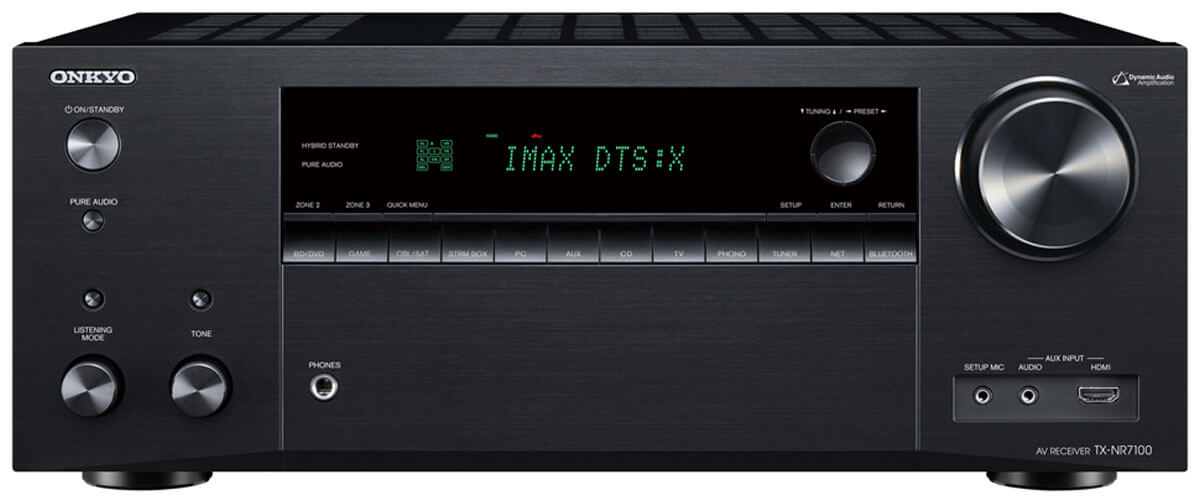
Looks and design are indeed subject to personal opinion. Too much depends on the individual taste, yet, Onkyo offers a true refreshment after the Denon AVR series and Marantz with their NR receivers. The TX-NR7100 offers versatility, having only one colossal volume control surface on the right side. On the left, it has two smaller knobs and several control buttons. It resembles classic receivers from the 90s - a traditional black box with multiple control buttons and several inputs.
From the ergonomic perspective, such a location is neither better nor worse than its competitors. All the difference lies in personal preferences, whether the control buttons should be located and how their color and display match the overall setup. The dimensions are also pretty standard for this class - 17-3/16"W x 6-13/16"H x 16-3/16"D. The same can be said about its weight - 22.9 lbs, which is a bit heavier than the AVR-X1700H from Denon.
Features and specs
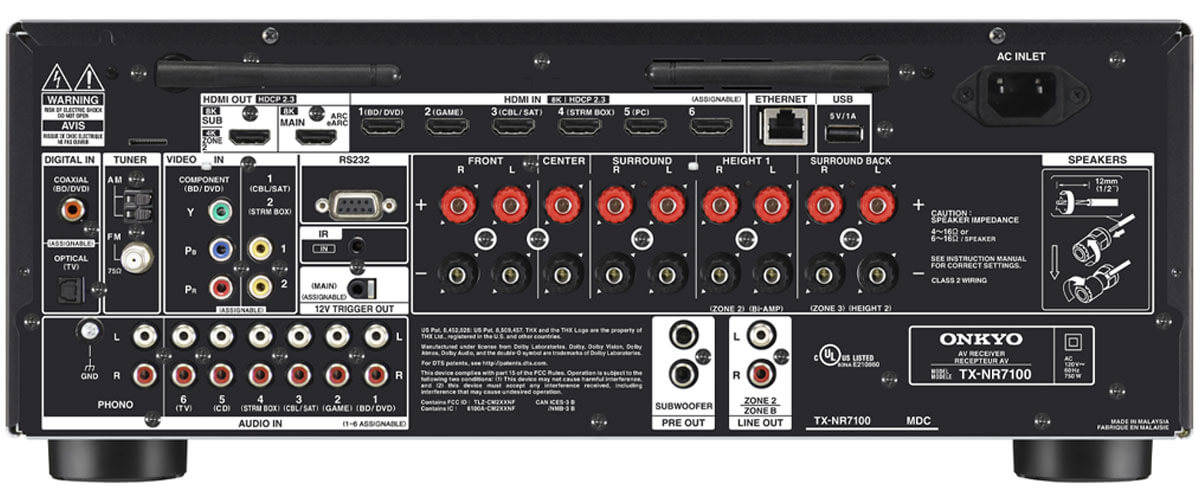
Onkyo TX-NR7100 offers 100 watts per channel with 8-ohm speakers at a classic 20-20.000 Hz rate with 0.08% THD, which is pretty standard for this price range. It was enough to provide a pleasant sound with my 5.4.4 setup, with no distortions or feelings of a lack of power. Regarding channels, the TX-NR7100 has a clear advantage over Denon AVR - X2700H and can be compared to the AVR-X3700H.
According to TX-NR7100 specifications, the receiver has 7 HDMI inputs, yet only the main one supports eArc/Arc. The number of HDMI outputs equals Denon AVR-X2700H and Marantz SR5015, which have 2. The unit includes component and composite video inputs, single phono, and two digital inputs. Altogether, this set of connectors allows the receiver to handle almost any device connected to it. It also has Bluetooth, Wi-Fi, and AirPlay 2 built-in, together with supporting current streaming services. Furthermore, the receiver supports Zone 3 feature, which is not very common in this price range.
Onkyo TX-NR7100 features the latest sound enhancement technologies, including DTS Neo:X, DTS:X, and IMAX Enhanced. The main HDMI inputs can support up to 8k/59-60HZ video, supplemented by HDR10+ family technology. At 4k resolution, one can watch movies or play games at 120hz. While in gaming, the receiver shows itself more or less equally to main competitors. It has a clear advantage over the AVR 2700H and SR5015 when watching movies as it is IMAX Enhanced, surpassing them in terms of picture, sound, and scale.
Like other AV receiver companies, Onkyo has its own room equalization and calibration technology - Accu-EQ. For those users who have no experience in tuning the receiver by themselves, this technology will seriously help. Indeed, a professional will tune the receiver much better, but Accu-EQ also does an excellent job.
Listening experience
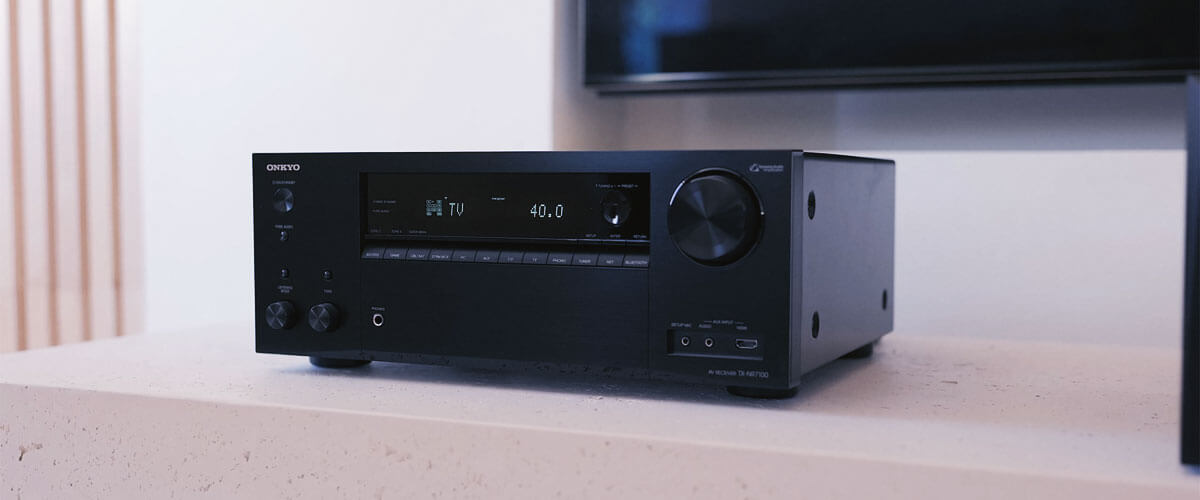
Concerning the price and support of the 9.2 channel, I was eager to put the receiver to the test with movies. I chose several more or less modern ones and undying classics to check the upscaling. I can't say the receiver takes the sound quality to the next level, but it has clear advantages over competitors. While supporting the same new surround audio sound formats and video technologies, it is IMAX Enhanced, which adds lots of quality to sound and pictures. Loved the bass parts and grainless dynamic moments.
The receiver fades when listening to music, offering no advantages over Denon AVR X1700H or Marantz NR5015. I can't say it sounded bad, yet I missed overtones usually inherent to Denon, Marantz, or Yamaha, considering their unique sound. Overall, the receiver shows itself to be very solid. I never felt like an Onkyo fanboy or even had any faith in it, yet, concerning the price, the TX-NR7100 is an excellent receiver that can genuinely compete with its rivals. Maybe if Onkyo had more models like the TXNR-7100, we would have heard more often about this company.
Key specs
- Channels: 9.2.
- Power output: 100W/8 Ohm, 220W/6 Ohm.
- HDMI inputs/outputs: 7/2.
- Video functions: 8K/60Hz, 4K/120Hz, 4K/60Hz pass-through, video upconversion (up to 1080p and 8K) for analog and HDMI sources.
- Bluetooth/Wi-Fi: yes/yes.
- Streaming services: AirPlay2, Deezer, Tidal, Pandora, SiriusXM, Napster, SoundCloud, Amazon Music, Amazon Music HD, Mood mix.
- Supports: HDMI ARC, HDMI eARC, HDMI CEC, HDCP2.3, HDR10, HDR10+, Dolby Vision.
- Surround sound: DTS HD Master, DTS Neural:X, Dolby TrueHD, Dolby Surround, Dolby Digital Plus, Dolby Atmos Height Virtualization, Dolby Atmos, IMAX Enhanced, DIRAC Live.
The 9-channel unit with Dolby Atmos support completes my list. Onkyo TX-NR7100 is an excellent receiver that can really compete with its rivals. And this is even though the manufacturing company does not have a wide range of products. It does a great job, whether watching movies in high-quality formats or gaming content.
Pros
- HDMI 2.1 with 8K and eARC.
- Supports Zone 3.
- IMAX Enhanced technology.
Cons
- The sound is too simple in some places.
FAQ
Is a Dolby Atmos receiver worth it?
So if you want to keep up with the times, appreciate the quality of surround sound, and get the most realistic sound in the home – a receiver with Dolby Atmos is worth every penny spent on it.
Can the 5.1 receiver play Dolby Atmos?
Is 7.1 surround the same as Dolby Atmos?
Does Netflix support Dolby Atmos?
In any case, the service only provides the ability to use such content for top-tier subscribers, so you should check your data plan options. After that, set the streaming quality to “High” or “Auto,” and enjoy the fantastic realistic sound. Let me remind you that all your devices must be Dolby Atmos compatible.
Those AV receivers also might be interesting for you:
We are supported by our audience. When you purchase through links on our site, we may earn an affiliate commission at no extra cost to you.
Our newsletter
* We will never send you spam or share your email with third parties

![Best Stereo Receivers [Reviewed and Tested]](https://mediapro-av.com/wp-content/uploads/2024/01/best-stereo-receiver-300x150.jpg)

